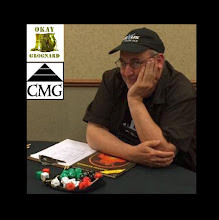The description from Board Game Geek is as follows:
In Ora et Labora, each player is head of a monastery in the Medieval era who acquires land and constructs buildings – little enterprises that will gain resources and profit. The goal is to build a working infrastructure and manufacture prestigious items – such as books, ceramics, ornaments, and relics – to gain the most victory points at the end of the game.
Ora et Labora, Uwe Rosenberg's fifth "big" game, has game play mechanisms similar to his Le Havre, such as two-sided resource tiles that can be upgraded from a basic item to something more useful. Instead of adding resources to the board turn by turn as in Agricola and Le Havre, Ora et Labora uses a numbered rondel to show how many of each resource is available at any time. At the beginning of each round, players turn the rondel by one segment, adjusting the counts of all resources at the same time.
Each player has a personal game board. New buildings enter the game from time to time, and players can construct them on their game boards with the building materials they gather, with some terrain restrictions on what can be built where. Some spaces start with trees or moors on them, as in Agricola: Farmers of the Moor, so they hinder development until a player clears the land, but they provide resources when they are removed. Clever building on your personal game board will impact your final score, and players can buy additional terrain during the game, if needed.
Players also have three workers who can enter buildings to take the action associated with that location. Workers must stay in place until you've placed all three. You can enter your own buildings with these workers, but to enter and use another player's buildings, you must pay that player an entry fee so that he'll move one of his workers into that building to do the work for you.
Ora et Labora features two variants: France and Ireland.
I don't have too much to add from yesterday's overview except to say that the prestigious items (worth victory points) should not be underestimated. In the four player game we played, the scores in other categories were virtually identical with one player winning entirely because of the additional points from those prestigious items and a single wonder. It should be pointed out that the ability to utilize the workers of others was used more extensively in this followup game and that mechanism disallows any player from getting a complete monopoly on production of prestigious items. While it might seem necessary to control their production to gain the lion's share of points from them, I'm not so sure it is. Allowing someone else to control such buildings and paying to have their worker use it for you also has the effect of tying up their worker, which can be an important part of a winning strategy. I'll play this one some more and keep an eye on how that plays out.
A look under the hood of various Games, Rules and Systems.
Please Like, Share, Plus, Tweet, Follow, and Comment!






No comments:
Post a Comment